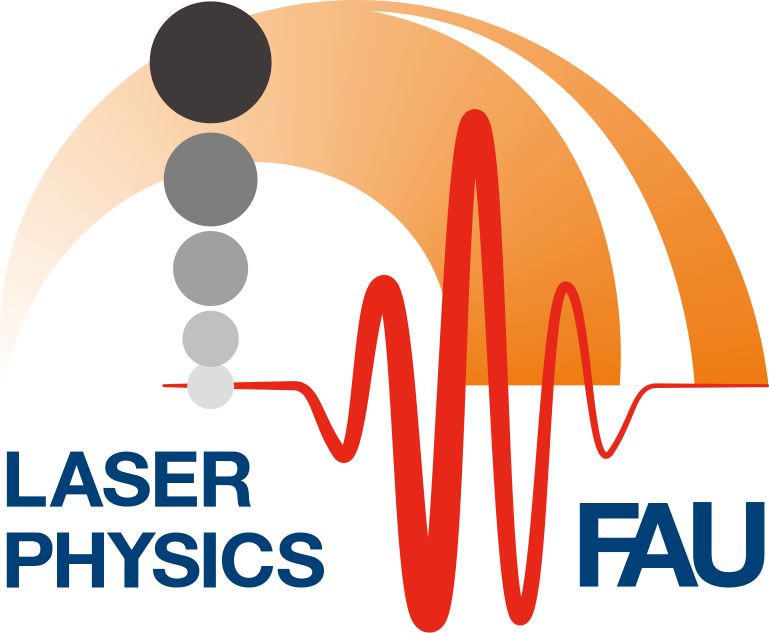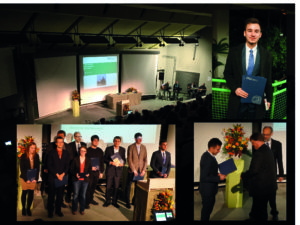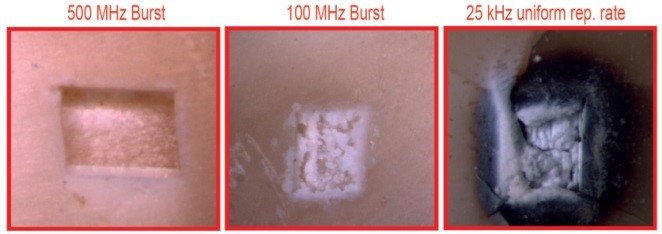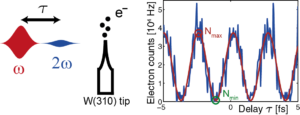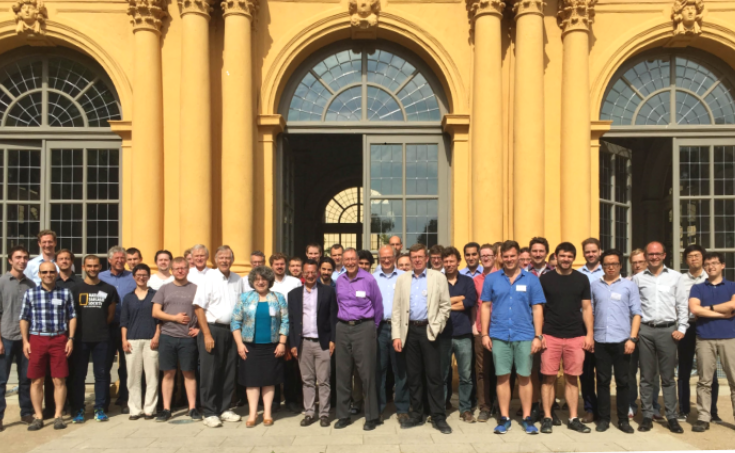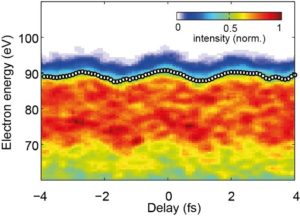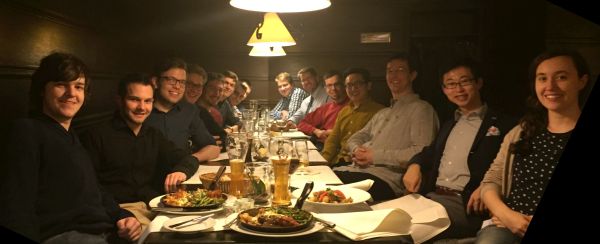News Archive
Manuscript on two-color photoemission published in PRL — with a commentary in “Physics”


Nov. 2016
Our two-color photoemission manuscript (M. Förster, T. Paschen et al. + colleagues from Vienna and Israel, see entry below dated Sept. 2016) has just been published in Physical Review Letters, highlighted with a commentary by Prof. Catherine Kealhofer with the title “Viewpoint: An Ultrafast Switch for Electron Emission.” We shouldn’t praise our own work here (still congratulations to the (first) authors!), but we can do so about the commentary — it is absolutely worth reading!
Web page of Prof. Catherine Kealhofer
Wep page of our partners around Prof. J. Burgdörfer, TU Wien, Vienna
Ohm Prize ceremony on 28/10/16
Our bachelor student René Barczyk was honored with an Ohm Prize at the graduation ceremony of the Department of Physics for his Bachelor thesis: “Characterisation of Graphene under Ultrastrong and Ultrashort Laser Pulses.” This award honours the best theses of the past year. In his work, René shows that the damage threshold of graphene under laser illumination strongly depends on the pulse duration. This result is of great interest for the investigation of novel strong-field phenomena in graphene.
Congratulations!
Ablation-cooled material removal with ultrafast bursts of pulses
Two bursts of ultrashort pulses in the time domain at fundamental pulse repetition rates of 100 MHz and 500.
Dental tissue material processing results at 500 MHz and 100 MHz ultrashort pulse bursts in comparison to removal results obtained in the traditional processing regime using uniform single pulse repetition rate at e.g. 25kHz. As illustrated, the ablation cooling regime enables a material removal circumventing heat-diffusion into the material that would lead to thermal damaging of the sample. Average power, processing time, single pulse temporal duration and beam size are maintained for each experiment.
For the last decades, laser systems emitting high energy ultrashort pulses represent a material processing tool of high precision and reliability. However, the traditional laser devices are limited in terms of short pulse repetition rates, typically located in the kHz-regime, in which the corresponding time window between two successive pulses allows for heat dissipation deep into the remaining material, potentially allowing for thermal damages. Here, we present a novel material processing technique circumventing these drawbacks by “recycling” the remaining heat that is deposited by the preceding pulse in the processing region before heat diffusion occurs. This implies that a) the already heated up material reduces the energy requirements for the successive pulse, and b) the immediately following ablation of the hot material significantly lowers the average power of the entire sample. This effect is defined as “ablation cooling”, and is used for atmospheric flights of e.g. ballistic warheads since the 1950’s. Applied to femtosecond laser pulse material processing, we have demonstrated an increase in ablation efficiency by up to an order of magnitude compared to the traditional processing procedures. The immediacy of the ablation-sequences is ensured by an extremely high fundamental repetition rate of ultrashort pulses, in which no uniform pulse trains but bursts of pulses are incident on the probe. A kHz-burst repetition rate allows for both optimization of the laser beam repositioning as well as lowering the laser beam average power. This novel material processing technique has been investigated in the research group of Prof. Dr. F.Ö. Ilday at University Bilkent, Ankara, Turkey, in collaboration with the Menlo Systems GmbH in Martinsried, Germany, where our PhD student Heinar Hoogland is working on his thesis. A detailed theoretical and experimental description of this new technique is published in Nature, September 1st 2016 (Vol. 537, No. 7618; pp. 7-128).
Manuscript on coherent control of nanotip photoemission accepted at Phys. Rev. Lett.:
In this experiment, femtosecond laser pulses of central wavelength 1560 nm (red) and 780 nm (blue) are incident on a tungsten nanotip with a variable delay [left]. The current emitted from the tip can be switched by virtue of the optical phase between the two laser pulses [right]. Sept. 2016
Nanotips are excellent electron emitters making them the prime choice for electron guns in electron microscopes. Therefore, also laser-triggered emission from nanotips has gained much attention. We now demonstrate that the laser-triggered current can be controlled almost perfectly with the phase between two simultaneously incident laser pulses of commensurate frequencies. As can be seen in the figure, modulation depths of up to 94% are reached in the experiment. With the help of density functional theory calculations performed by the group of Prof. Burgdörfer at TU Vienna we investigate the mechanism of control. We find that our results can be explained in terms of two different quantum pathways leading to electron emission, where the phase between the quantum pathways plays the role of a switch. Our research opens the door for further studies of coherence at solids on a fundamental level but also to create electron pulses of a desired spatio-temporal shape.
A preprint of our research can be found on arXiv: https://arxiv.org/abs/1603.01516
ACHIP collaboration meeting at FAU
The ACHIP (Accelerator on a CHip International Program) collaboration held its semiannual conference in Erlangen on September 15-16th, 2016, hosted and organized by our team at FAU. The collaboration members from Stanford University, UCLA, TU Darmstadt, Purdue University, Paul Scherrer Institute, DESY, SLAC, Tech-X and FAU not only presented their recent accomplishments but also discussed future directions of the collaboration, with guidance from an advisory board consisting of Professors Lia Merminga, Chan Joshi and Reinhard Brinkman. The collaboration looks forward towards research aiming to realize the goal of a laser based miniaturized accelerator on a chip.
The participants of the ACHIP collaboration workshop in front of the meeting hall, FAU’s Orangerie. Sept. 2016.
Hiking tour in Franconian Switzerland
Group pictures of the attendees of the hiking tour at the start in Ebermannstadt. Sept. 2016
Light-field-driven currents in graphene
Measurement setup for the generation of light-waveform-dependent currents in graphene (left). Graphene’s characteristic “Dirac-cone” dispersion relation significantly relaxes the requirement to bring electrons into the light-field driven regime, and electrons undergo combined dynamics of band-to-band transitions and acceleration within single bands (right). July 2016.
We show that one can control an electric current flowing in graphene, an atomically thin layer of carbon atoms, by the optical field of light. The current is determined by the optical field waveform oscillating on a timescale of 1 femtosecond (1/1,000,000,000,000,000 second), which is one millionth of a billionth of a second, and orders of magnitudes faster than the fields that drive electrons in common electronics. This finding represents a major step in the rapidly growing interdisciplinary field of strong-field physics in solids by broadening its scope to an entirely new and eminently important material class – metals –. A door is opened for integrating two important technologies, optics and electronics, to a single platform on the basis of controlling electrons by an optical electric field.
preprint on arXiv https://arxiv.org/abs/1607.04198
Near fields at nanotips captured with attosecond streak camera
Modulation of the photoelectron spectrum from a nanotip as a function of delay between photoemitting XUV pulse and an IR pulse, which excites a near field. May 2016
Nanostructures allow to concentrate electromagnetic fields to scales much smaller than the wavelength of light – this is in stark contrast to free space, where the wavelength forms a natural barrier. This idea is the foundation of the field of nano-optics and we use it extensively in our experiments, for example for photoemission from nanotips and for dielectric laser acceleration. Together with our colleagues of the Max Planck Institute of Quantum Optics and the Ludwig-Maximilians-Universität in Munich we have now succeeded for the first time to determine the strength and temporal shape of a near field with attosecond resolution. To this end we use an infrared laser pulse to excite a near field at a nanotip. An attosecond XUV pulse simultaneously emits photoelectrons from the tip. The photoelectron energy at the detector is dependent on the exact phase and strength of the near field at the time of photoemission. We can therefore reconstruct the near field from the modulation of the highest electron energy as a function of delay between IR and XUV pulse.
Publication in Nature Communications
Les Houches–WE-Heraeus-Workshop on Ultrafast Phenomena at Nanostructures: Attosecond physics meets plasmonics
The workshop participants. May 2016
The topic of the highly successful workshop was science at the interface of nanoplasmonics and strong field physics, and was organized by Benoit Chalopin (Toulouse), Stephan Götzinger (FAU) and our group. 24 invited speakers presented their research, as well as many younger colleagues in two poster sessions. Discussions were intense and fruitful, so that we expect that a number of new research ideas have been born at the workshop. Many thanks again to the Les Houches Physics Center as well as the WE-Heraeus Foundation, whose support was crucial to the success of the workshop.
Two PhDs in one day: Drs. Förster und Thomas
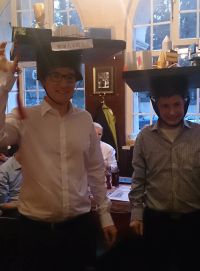
Dr. Förster and Dr. Thomas. April 2016
A double strike, a double very good one on top: this is the result of the dissertation defenses of now Dr. Förster and Dr. Thomas. Warmest congratulations!
DPG meeting 2016
The large delegation of FAU’s Laser Physics and two always welcome friends at DPG spring meeting in Hannover. March 2016
Workshop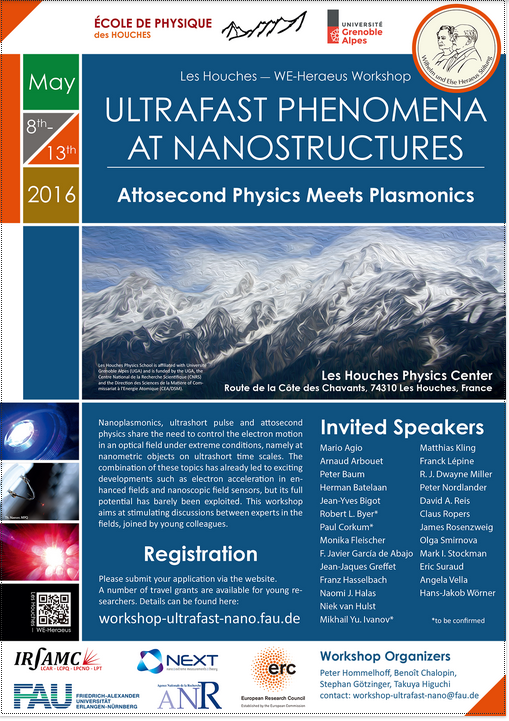
Please klick on image for a readable version. Jan. 2016
Jointly with French colleagues and generously supported by the Wilhelm and Else Heraeus Foundation we are organizing a workshop on “Ultrafast phenomena at nanostructures: attosecond physics meets plasmoncis”. We are glad that many high-level speakers have agreed to present their work. The workshop will take place in the magnificent French physics center Les Houches in the French alps. Younger scientists can apply for travel support. Please follow the link for further information and registration.
Accelerator on a chip: AChIP collaboration founded
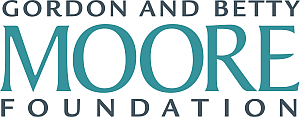
Nov. 2015.
With generous support from the private Gordon and Betty Moore Foundation, an international collaboration has been founded with the name AChIP: Accelerator on a Chip International Program. The goal of this program is to demonstrate compact accelerators based on dielectric laser acceleration of electrons.
The first demonstration experiments on this kind of particle acceleration have been performed at Stanford/SLAC and in our group in 2013, on which the AChIP collaboration, headed by Stanford and our FAU group, is based; initial theory work on this particle acceleration scheme date back more than half a century. The idea of dielectric laser acceleration is to have electrons interact directly with the optical field of intense laser pulses. This only leads to an energy increase of the electrons if they pass by a photonic structure that modulates the light phase appropriately. This way, the electrons can gain energy a factor 100 faster than in traditional accelerators, which will allow to build these new particle accelerators smaller by about the same factor. More details on the physics background and the AChIP collaboration can be found by clicking on the link “Research” on the left of this web site, and then further on “Electron acceleration with laser light”.
The Gordon and Betty Moore Foundation has been established by Intel Co-Founder Gordon Moore (Moore’s Law) and his wife Betty. The Foundation has already invested more than one billion Dollar into research projects. Next to research, the Foundation supports projects on patient care, the environment and the San Francisco Bay Area. In our group, the Quantum Electron Microscope Project is also generously supported by the Moore Foundation.
Link to the Gordon and Betty Moore Foundation
Link to our 2013 original research paper on dielectric laser acceleration
Also see below the paragraphs on “Economist” and “PRL out on laser acceleration”.
Link to the science blog IFLScience
Link to FAU blog (contribution by Lisa Wolf, in German)
Open PhD student positions available
At a number of our experiments open PhD student positions are available. We look forward to receiving your application! Please send us your application material (CV, transcripts etc.) any time. Kindly let us know when you would like to start (no restrictions from our side), and if you have specific interests.
Nature commentary published
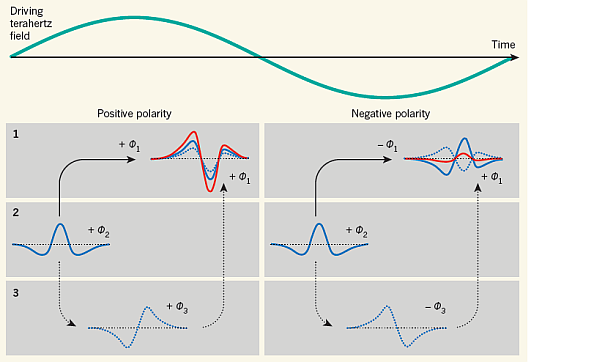
July 2015. Electron tunneling path ways interfere pepending on the polarity of the driving pulse. Depending on the exact pathway, the result may lead to constructive or destructive interference, which is reflected in the amount of resulting high-harmonic radiation emitted. This is what Hohenleutner and colleagues have found and just published in Nature. Image: we with Nature in News and Views commentary.
In an impressive combined experimental-theoretical work, the research groups around Profs. Rupert Huber (Regensburg), Stephan Koch and Mackillo Kira (both Marburg) have found out that interference effects may dominate the resulting high harmonic spectra in strong-field induced tunneling of electrons between various bands in a crystal. The research journal “Nature” has invited us to write a commentary about the work, which has just been published jointly with the original article.
Original research article by Hohenleutner et al. in Nature
Nature News and Views: commentary by Hommelhoff und Higuchi
Research group Prof. Huber in Regensburg
Research group Profs. Kira and Koch in Marburg
Otto Hahn Medal to Michael Krüger
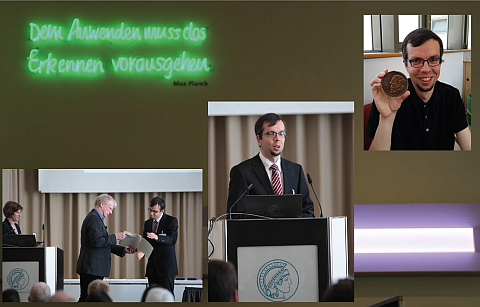
June 2015 at Harnack House of the Max Planck Society in Berlin. Max Planck Society Vice President Prof. Schüth is awarding Dr. Michael Krüger with the Hahn Medal.
Dr. Michael Krüger, former PhD student and postdoc in our group, has won the Otto Hahn Medal of the Max Planck Society. This prestigous award was given to him for the outstanding results of his dissertation, namely “for the investigation of ultrafast electronic processes at nano structures with the help of phase-controlled laser pulses.” Congratulations!
Press release of Max Planck Institute of the Science of Light
Press release of Max Planck Institute for Quantum Optics
Electron beamsplitter manuscript out in Phys. Rev. Lett. together with Synopsis

June 2015
Physical Review Letters has highlighted our paper on electron beamsplitting, which just appeared, with a synopsis in “Physics” called “Chip-sized beamsplitters for electrons”.
Group picture!
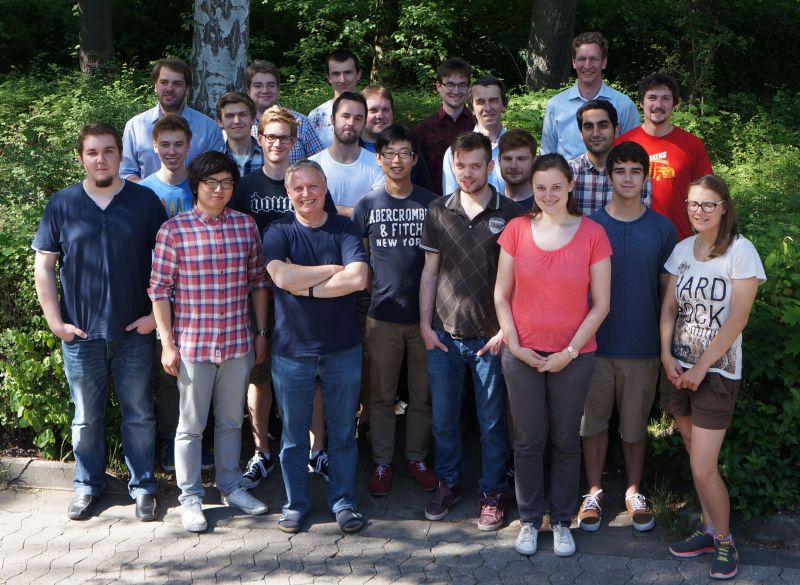
A new beamsplitter for slow electrons — manuscript accepted at PRL
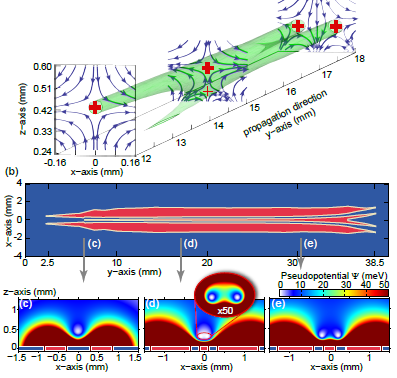
June 2015
In our experiment on electron guiding with the help of microwave fields we could now show that pretty complex potentials can be generated with the help of the lithographically produced structures. As a first important application, we have realized a beam splitter for electrons. Instead of only generating a quadrupole field as required for guiding, we have here generated a hexapole field configuration. It allowed us to split up an incoming electron beam into two output beams, see Fig. The manuscript on this work has just been accepted for publication in Phys. Rev. Lett.
Laser-triggered electrons almost as superbly coherent as DC-field emitted electrons — publication accepted at PRL.
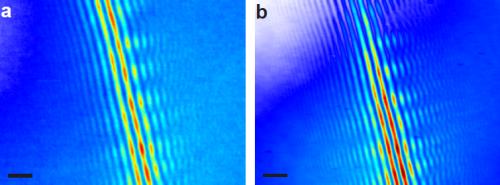
May 2015
With the help of a carbon nanotube-based electron biprism beamsplitter we have recoreded electron matter wave interference fringes (see figure). The spacial extent of the interference fringes is a direct measure of the coherence of the electron beam. As can be clearly seen above, the two interference images and thus the coherence of the two electron beams is about the same. On the left, electrons laser-emitted from a sharp tip interfere, whereas on the right DC field emitted electrons interfere. It is well-known that DC field emitted electron beams posses the highest coherence of standard electron sources, which is why these sources are employed in the best electron microscopes, in so-called cold field emission or CFE guns. It is of great interest for future applications in time-resolved electron based imaging methods that laser-triggered electron beams posses a coherence almost as large as that of a DC field emitted beam. The manuscript describing this great result has just been accepted for publication in Physical Review Letters. It is noteworthy that it is mainly the result of Dominik Ehberger’s master thesis — and a nice collaborative effort with our partners of LMU Munich who allowed us to use their recipe to grow carbon nanotubes over a holey carbon film in their cleanroom. Jakob Hammer’s special vacuum chamber and his assistance were the third essential ingredient.
Group of our collboration partner around Prof. Dr. A. Högele, LMU Munich
Field enhancement at sharp tips — an old topic, finally understood? Publication accepted at NJP.
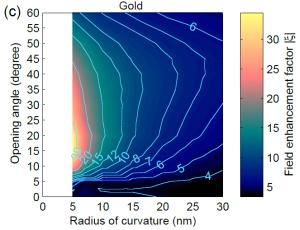
April 2015
Everyone knows the lightning rod effect. A similar effect shows up at sharp tips with optical fields. This optical field enhancement at sharp tips is of common use, for example in scanning near-field optical microscopy (SNOM) or tip-enhanced Raman scattering (TERS). In our lab we utilize optical field enhancement at sharp objects to generate optical field strengths large enough to enter the strong-field regime of electron emission. In our publication, which was now accepted for publication in New Journal of Physics, we show, jointly with our long-time collaboration partners of TU Vienna, that optical field enhancement not only increases with decreasing tip radius (as expected and well known for a long time), but that the opening angle of the tip also has a large effect. This was surprising and little understood so far. We have thus not only performed numerical simulations but also came up with a simple and intuitive model to understand why a relatively large opening angle leads to maximum field enhancement, see figure. This behavior shows up for many materials.
Publication in New Journal of Physics
Group of our collboration partner around Prof. Dr. J. Burgdörfer, TU Vienna
What happens on attosecond time scales in materials of nanometer size?
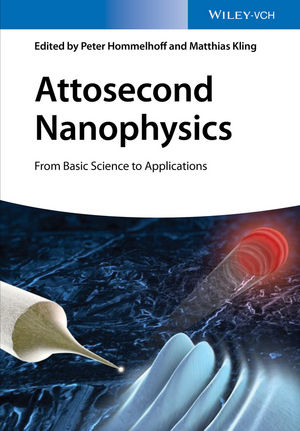
Feb. 2015
This question turned center stage for many research groups worldwide. For the first time, modern methods of femto- and attosecond physics allow observing electronic processes in nanoscale materials on their natural timescales. The so obtained basic science insights are of direct relevance for many applications, such as light-driven electronics. Matthias Kling and Peter Hommelhoff, professors of physics at Munich University and Erlangen University, respectively, have edited a book that gives an overview of this fast paced research field. In ten chapters, each written by authors leading their research area, the current state of the art is summarized. The book is intended for graduate students to obtain an overview of the field, as well as for more experienced scientists as a reference book.
Wiley web site on the book (containing the table of contents, and more)
Press release of the DFG Cluster of Excellence Munich Centre for Advanced Photonics
Ultrafast miniaturized tube diode: manuscript accepted for publication in Applied Physics Letters — and published.
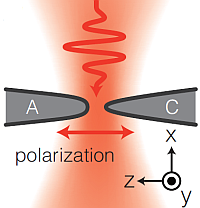
Jan. 2015
Diodes are important passive microelectronics elements, representing one-way streets for electrons. We could show that such diodes can be conceived for laser-pulse driven photoemission. We employ two metal tips facing each other with two different radii of curvature. Because laser field enhancement is stronger at the sharper tip, a net electron current flows from it to the blunter tip. Because the driving laser pulses are of a few femtoseconds duration, and because the tips are placed only 300nm apart from each other, this system represents an extremely fast diode — a light-driven ultrafast nanoscale tube diode. These results have been accepted for publication in Applied Physics Letters and represent another step towards “lightwave electronics” or petahertz electronics.
Link to Appl. Phys. Lett. contribution
Patent granted for a new method to stabilize the carrier-envelope offset frequency of femtosecond laser pulses

Jan. 2015
It took a while but now it’s here: our patent application for a new method to measure and stabilize the carrier-envelope phase and the carrier-envelope offset frequency of femtosecond laser pulses has been granted by the European Patent Office. We are open to discuss opportunies with interested companies.
Overview article on dielectric laser acceleration published

Dez. 2014
Another nice early christmas present, just one day early, was kindly delivered by Reviews of Modern Physics. They published a large, 53 pages long review article on dielectric laser acceleraion. It summarizes the state of the art of this hot research field, which is just taking off the ground with full thrust — partly also because of two incidents dated Aug. 2013 here.
Link to Reviews of Modern Physics paper
Dr. Hammer!
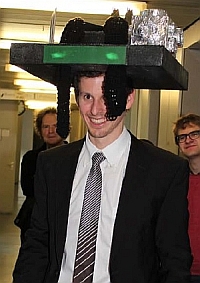
Dr. Hammer with hat. Dec. 2014
Jakob Hammer made himself and all of us a nice early christmas present: he defended his dissertation with distinction. Congratulations!
Michal Hamkalo awarded gold medal for his Bachelor thesis by the Polish Academy of Sciences
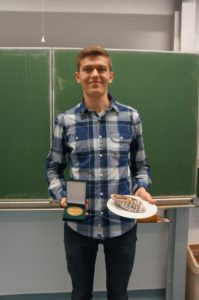 Michal’s thesis ‘Studies of Phase Transfer Catalysis by Second Harmonic Generation’ was awarded the first price by the Polish Academy of Sciences and the DuPont foundation in the category chemistry, biology and physics. Despite the importance of phase transfer catalysis for chemical synthesis a direct proof of the mechanism has until now been elusive. In his bachelor thesis in Warsaw Michal used a femtosecond laser to induce surface second harmonic generation. This allowed him to investigate the theoretical foundation of phase transfer catalysis and also to extend it. Congratulations!
Michal’s thesis ‘Studies of Phase Transfer Catalysis by Second Harmonic Generation’ was awarded the first price by the Polish Academy of Sciences and the DuPont foundation in the category chemistry, biology and physics. Despite the importance of phase transfer catalysis for chemical synthesis a direct proof of the mechanism has until now been elusive. In his bachelor thesis in Warsaw Michal used a femtosecond laser to induce surface second harmonic generation. This allowed him to investigate the theoretical foundation of phase transfer catalysis and also to extend it. Congratulations!
Manuscript about gray levels in interaction-free measurements published in Phys. Rev. A
Nov. 2014
Interaction-free measurements exploit quantum effects to detect the presence or absence of an object while minimizing the disturbance of the object. That this is possible has been demonstrated in experiments with photons. In close collaboration with Christoph Kohstall (Stanford Univ.) and Pieter Kruit (TU Delft), we perform numerical simulations to find out how interaction-free measurements perform in the determination of gray levels and phase shifts. In this way, we study the theoretical foundations of a quantum electron microscope.
Paper in Phys. Rev. A: http://journals.aps.org/pra/abstract/10.1103/PhysRevA.90.053840
Link to the manuscript on arXiv: http://arxiv.org/abs/1409.0044
Link to the Quantum Electron Microscope collaboration: http://www.rle.mit.edu/qem/
Two great publications on one day
![]() Publishing two papers in two top journals — this is something great to anyone when it happens within a year, but Dr. Takuya Higuchi managed to do so on a single day, even within one hour. Congratulations!
Publishing two papers in two top journals — this is something great to anyone when it happens within a year, but Dr. Takuya Higuchi managed to do so on a single day, even within one hour. Congratulations!
Paper in Physical Review Letters on HHG in Solids, see below
Publication on electron trigger accepted for publication in Phys. Rev. Appl.
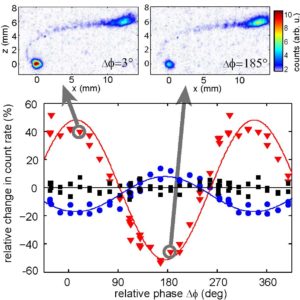
The phase of the microwave drive at the moment of entrance of electrons into the electron guide determines the injection efficiency. Oct. 2014
The manipulation of electrons above a planar surface-electrode microwave chip augments the already available electron toolkit by an entirely new set. We provide a viable strategy to directly inject electrons into low-lying motional quantum states of a linear electron guide, which represents a decisive step towards guided matter-wave interferometry and new quantum optics experiments with electrons using this technique.
Manuscript on theory of high harmonic generation accepted for publication in Phys. Rev. Lett.
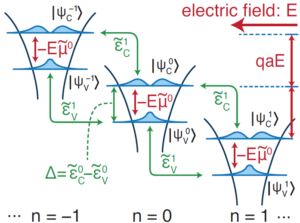
A Wannier-Strark ladder is established in a solid under the action of a strong laser field, allowing for interband tunneling and high harmonic generation. Oct. 2014
A paper of ours on the theory of high harmonic generation in a solid, mainly developed by Takuya Higuchi, was just accepted for publication in Phys. Rev. Lett. A purely theoretical work that arose from a close collaboration with Mark Stockman (LMU Munich and Georgia State Univ.) it contains an investigation on the effects of strong laser pulses on a solid. Based on Floquet theory, we have developed a model that allows insightful understanding of HHG spectra measured from solids. By virtue of this model we also predict the generation of attosecond pulses from solids.
